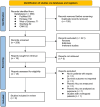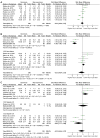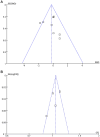The association of plasma homocysteine levels with short-term mortality in sepsis patients: A meta-analysis
- PMID: 39484786
- PMCID: PMC11959389
- DOI: 10.17305/bb.2024.11259
The association of plasma homocysteine levels with short-term mortality in sepsis patients: A meta-analysis
Abstract
The association between plasma homocysteine (Hcy) levels and short-term mortality in sepsis patients remains unclear. This meta-analysis aimed to clarify this potential relationship. Following PRISMA 2020 and Cochrane Handbook guidelines, we conducted a comprehensive literature search in the PubMed, Embase, and Web of Science databases up to June 24, 2024. We included cohort studies that assessed the association between plasma Hcy levels and all-cause mortality in adult sepsis patients. Standardized mean differences (SMDs) and odds ratios (ORs) with 95% confidence intervals (CIs) were calculated using a random-effects model to account for potential heterogeneity. Nine cohort studies involving 771 sepsis patients were included. Overall, no significant difference in plasma Hcy levels was observed between survivors and non-survivors (SMD: -0.23, 95% CI: -0.84 to 0.37, P = 0.45), with substantial heterogeneity (I² = 86%). Subgroup analysis revealed lower plasma Hcy levels among survivors in Chinese patients (SMD: -1.56, 95% CI: -1.98 to -1.13, P < 0.001) but not in non-Asian patients. Plasma Hcy levels were not significantly associated with all-cause mortality (OR per 1-unit increment: 1.03, 95% CI: 0.95 to 1.11, P = 0.51), with notable heterogeneity (I² = 72%). However, a significant association was found in Chinese patients (OR: 1.09, 95% CI: 1.03 to 1.15, P = 0.003), but not in non-Asian patients. In conclusion, plasma Hcy levels were not generally associated with short-term mortality in sepsis patients. However, significant associations were observed in Chinese patients, suggesting potential ethnic differences that warrant further investigation.
Conflict of interest statement
Conflicts of interest: Authors declare no conflicts of interest.
Figures






Similar articles
-
Homocysteine, vitamin B12, and folate levels in patients with multiple sclerosis in Chinese population: A case-control study and meta-analysis.Mult Scler Relat Disord. 2019 Nov;36:101395. doi: 10.1016/j.msard.2019.101395. Epub 2019 Sep 10. Mult Scler Relat Disord. 2019. PMID: 31521916
-
Association between Homocysteine Levels and All-cause Mortality: A Dose-Response Meta-Analysis of Prospective Studies.Sci Rep. 2017 Jul 6;7(1):4769. doi: 10.1038/s41598-017-05205-3. Sci Rep. 2017. PMID: 28684797 Free PMC article.
-
Plasma homocysteine concentrations and risk of intracerebral hemorrhage: a systematic review and meta-analysis.Sci Rep. 2018 Feb 7;8(1):2568. doi: 10.1038/s41598-018-21019-3. Sci Rep. 2018. PMID: 29416106 Free PMC article.
-
Serum levels of Homocysteine, Vitamin B12 and Folate in Patients with Multiple Sclerosis: an Updated Meta-Analysis.Int J Med Sci. 2020 Mar 5;17(6):751-761. doi: 10.7150/ijms.42058. eCollection 2020. Int J Med Sci. 2020. PMID: 32218697 Free PMC article.
-
Elevated homocysteine levels in patients with heart failure: A systematic review and meta-analysis.Medicine (Baltimore). 2021 Aug 20;100(33):e26875. doi: 10.1097/MD.0000000000026875. Medicine (Baltimore). 2021. PMID: 34414939 Free PMC article.
References
-
- Gotts JE, Matthay MA. Sepsis: pathophysiology and clinical management. BMJ. 2016;353:i1585. https://doi.org/10.1136/bmj.i1585. - PubMed
-
- Desposito L, Bascara C. Review: sepsis guidelines and core measure bundles. Postgrad Med. 2024;136:702–11. https://doi.org/10.1080/00325481.2024.2388021. - PubMed
-
- Rudd KE, Johnson SC, Agesa KM, Shackelford KA, Tsoi D, Kievlan DR, et al. Global, regional, and national sepsis incidence and mortality, 1990-2017: analysis for the global burden of disease study. Lancet. 2020;395(10219):200–11. https://doi.org/10.1016/S0140-6736(19)32989-7. - PMC - PubMed
-
- Chiu C, Legrand M. Epidemiology of sepsis and septic shock. Curr Opin Anaesthesiol. 2021;34(2):71–6. https://doi.org/10.1097/ACO.0000000000000958. - PubMed
-
- Markwart R, Saito H, Harder T, Tomczyk S, Cassini A, Fleischmann-Struzek C, et al. Epidemiology and burden of sepsis acquired in hospitals and intensive care units: a systematic review and meta-analysis. Intensive Care Med. 2020;46(8):1536–51. https://doi.org/10.1007/s00134-020-06106-2. - PMC - PubMed

